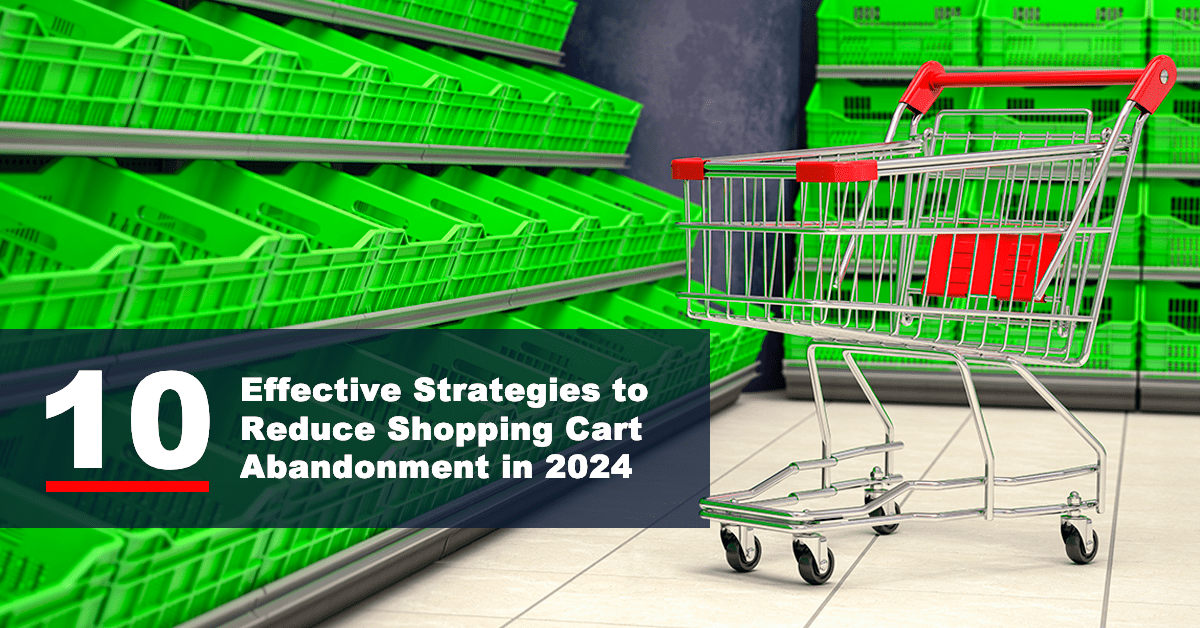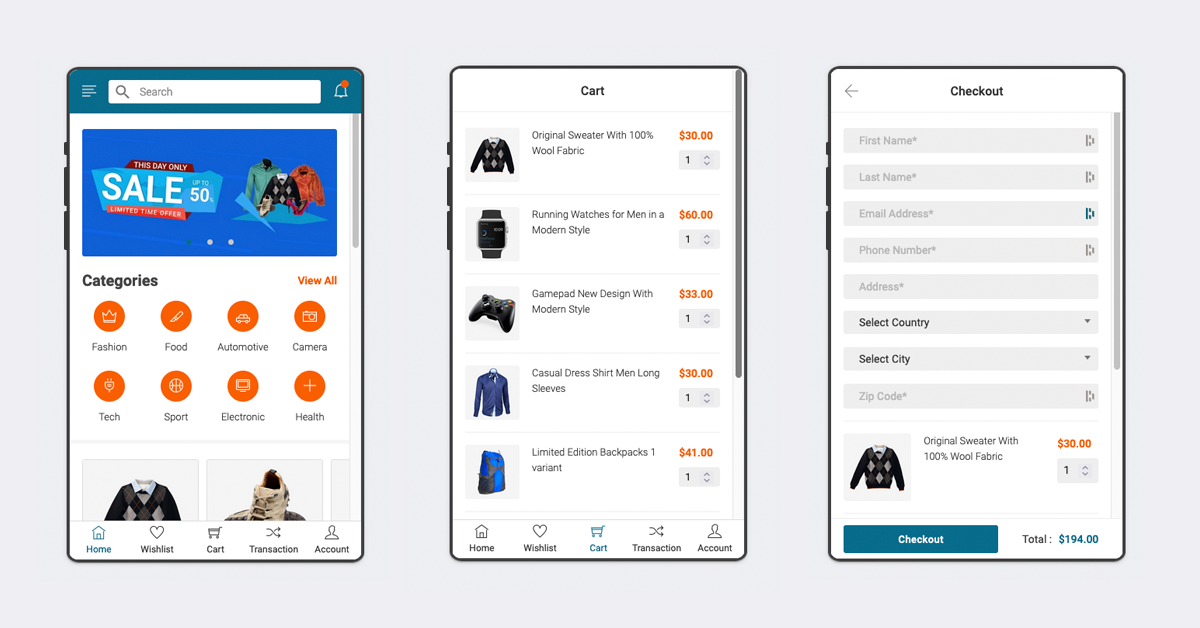
In the ever-evolving world of digital commerce, the challenge of shopping cart abandonment remains a critical hurdle for online retailers. As we step into 2024, the urgency to understand and mitigate the factors leading to abandoned carts has intensified. This comprehensive guide delves into “10 Effective Strategies to Reduce Shopping Cart Abandonment in 2024,” offering a deep dive into innovative and practical solutions.
From optimising the e-commerce checkout experience to leveraging data analytics and engaging customer interaction strategies, this article provides a roadmap for online retailers to enhance their checkout processes, tailor customer experiences, and ultimately, convert abandoned carts into successful sales. Embrace these insights to stay ahead in the competitive digital marketplace and transform your e-commerce challenges into opportunities for growth and customer loyalty.

1. E-commerce Checkout Optimisation
In the dynamic world of e-commerce, the phenomenon of shopping cart abandonment presents a significant challenge. As we move into 2024, it’s more important than ever for online retailers to understand and address the reasons why customers might leave their carts without completing a purchase. The checkout process is a critical juncture in the customer’s journey; it’s the moment when the shopper decides whether to proceed with their purchase or abandon it. Optimising this process is therefore essential for improving conversion rates and overall profitability.
Effective checkout optimisation involves a thorough analysis of the existing process and identifying areas where customers might be experiencing friction or frustration. This could be anything from a complicated navigation system, unexpected costs being added, a lack of payment options, or even concerns about security. Once these issues are identified, retailers can take steps to streamline the process. This might include simplifying forms, providing clear and transparent pricing information, offering a variety of payment methods, and ensuring the checkout is secure and trustworthy.
Moreover, the checkout experience should be consistent with the rest of the website in terms of design and messaging. Consistency helps in building trust and reassurance, which are crucial in convincing customers to complete their purchases. Retailers should also consider the different paths customers take to reach the checkout and optimise each path to ensure a smooth transition. By focusing on these areas, businesses can significantly reduce the rate of shopping cart abandonment and increase their sales.

2. Streamlined Checkout Process
The checkout process in e-commerce is often where the battle for customer conversion is won or lost. A streamlined checkout process is not just about reducing the number of steps, but about creating a journey that is intuitive, efficient, and hassle-free. In 2024, customers expect a checkout experience that is quick and straightforward.
To streamline the process, retailers should start by analysing their current checkout flow. Are there unnecessary steps that can be eliminated? Can information be auto-filled to save time? Is the process intuitive enough for someone who is not tech-savvy? Simplifying the process might involve reducing the number of pages, combining steps where possible, and eliminating any non-essential fields in forms.
Another key aspect is to provide clear instructions and feedback throughout the process. Customers should always know what step they are on, what is required of them, and what comes next. Progress indicators can be very effective in this regard. Additionally, offering options like guest checkout can significantly reduce barriers for new customers who might be hesitant to create an account.
Retailers should also consider the visual aspect of the checkout process. A cluttered or visually overwhelming checkout page can be off-putting. Keeping the design clean, simple, and in line with the rest of the site can help maintain the customer’s focus and reduce cognitive load, thereby encouraging them to complete the purchase.

3. Mobile-Friendly Checkout
With the increasing prevalence of smartphones, a mobile-friendly checkout process is no longer just an option, but a necessity. In 2024, a significant portion of online shopping is done via mobile devices, and retailers who fail to optimise their checkout process for mobile are likely to see higher rates of cart abandonment.
A mobile-friendly checkout process should be designed with the limitations and advantages of mobile devices in mind. This means large, easy-to-tap buttons, minimal text input, and fast loading times. Since typing on mobile can be cumbersome, reducing the amount of required typing by using dropdowns, toggles, and auto-fill can greatly enhance the user experience.
Moreover, the checkout process should be responsive, meaning it should adapt to different screen sizes and orientations seamlessly. This includes not just the layout, but also the size of clickable elements, the visibility of essential information, and the overall navigational flow.
Another important aspect is the integration of mobile payment options like Apple Pay, Google Wallet, or other region-specific mobile payment methods.
These options can significantly speed up the checkout process and provide a more secure way for customers to pay. Additionally, ensuring that all security and privacy measures are in place and clearly communicated can help build trust with mobile users, who may have concerns about the security of mobile transactions.

4. Effective Customer Engagement
In the realm of e-commerce, effective customer engagement is a cornerstone for reducing shopping cart abandonment. In 2024, with the ever-increasing competition in the online marketplace, engaging customers effectively is not just about attracting them to your site, but also about providing an experience that keeps them coming back.
Customer engagement starts with understanding your audience. What are their needs, preferences, and pain points? Utilising data analytics to gather insights about your customers can help tailor the shopping experience to their preferences. Personalisation plays a key role here. From personalised product recommendations to customised email marketing, showing customers that you understand their needs can significantly enhance engagement.
Interactive elements such as chatbots, AR/VR experiences, and interactive product demos can also elevate the customer experience. These tools not only provide value to the customer but also create memorable experiences that can differentiate your brand from competitors.
Moreover, consistent and meaningful communication is vital. Whether it’s through social media, email newsletters, or blog posts, keeping in touch with your customers and providing them with valuable content can help build a community around your brand. Engaged customers are more likely to return to your site, and when they do, they’re more likely to complete their purchases.

5. Personalised Shopping Experience
The personalised shopping experience is a powerful tool in the arsenal of e-commerce strategies. In 2024, personalisation has moved beyond simply addressing the customer by name in an email. It’s about curating the entire shopping experience to align with individual customer preferences and behaviours.
Advanced algorithms and machine learning can be used to analyse customer data and predict shopping patterns. This allows for the automatic recommendation of products that the customer is likely to be interested in. But personalisation doesn’t stop at product recommendations. It extends to customising the user interface, marketing messages, and even the checkout process based on the customer’s past behaviour and preferences.
For instance, if a customer frequently purchases eco-friendly products, the website can highlight these products more prominently for that customer. Similarly, if a customer often abandons carts because of high shipping costs, offering them a personalised discount on shipping can encourage them to complete the purchase.
Personalisation also means providing a consistent experience across all channels, whether the customer is shopping on a desktop, mobile device, or even in a physical store. This omni-channel approach ensures that the customer feels recognised and valued, regardless of how they choose to interact with your brand.

6. Interactive Product Recommendations
Interactive product recommendations are a step beyond traditional product suggestions. In 2024, these are sophisticated systems that not only suggest products based on browsing history but also engage customers in a more interactive and dynamic way.
One method is through quizzes or questionnaires that customers can fill out to receive tailored recommendations. This not only helps in providing more accurate suggestions but also increases customer engagement with the site. Another approach is using augmented reality (AR) to allow customers to see how a product would look in their own environment, whether it’s a piece of furniture in their living room or a new shade of lipstick.
These interactive systems can also leverage real-time data to adjust recommendations on the fly. For example, if a customer is browsing winter coats, the system can immediately start showing accessories like gloves and scarves to complement the coat.
The key to successful interactive product recommendations is a seamless integration into the shopping experience. They should be intuitive, easy to use, and, most importantly, relevant to the customer’s interests. When done right, they can significantly enhance the shopping experience, leading to increased customer satisfaction and reduced cart abandonment.

7. Customer Behaviour Analysis
Understanding customer behaviour is crucial in e-commerce, especially when it comes to reducing shopping cart abandonment. In 2024, with the vast amount of data available, analysing customer behaviour has become more sophisticated and insightful. This analysis involves studying how customers interact with your website, what products they view, how long they spend on certain pages, and at what point they abandon their carts.
By examining these patterns, retailers can identify potential pain points in the customer journey. For instance, if a significant number of customers are abandoning their carts on the payment page, this could indicate an issue with the payment options or process. Similarly, if customers are leaving after viewing shipping costs, it might suggest that the shipping fees are too high or the delivery times are too long.
Retailers can use various tools and techniques for this analysis, including heat maps, session recordings, and analytics platforms. These tools provide a deeper understanding of customer behaviour, allowing retailers to make data-driven decisions to enhance the shopping experience.
Moreover, segmenting customers based on their behaviour can lead to more targeted and effective strategies. For example, customers who frequently browse but never purchase could be targeted with special offers or reminders, while those who make regular purchases might benefit from a loyalty program.

8. Utilising Data Analytics
Data analytics in e-commerce is about turning vast amounts of customer data into actionable insights. In 2024, data analytics has become more advanced, with the ability to not only track customer behaviour but also predict future trends and preferences.
Effective use of data analytics involves collecting data from various sources, including website interactions, social media, customer feedback, and purchase history. This data is then analysed to identify patterns and trends. For instance, analytics can reveal which products are most popular at different times of the year, which marketing campaigns are most effective, or what factors contribute to cart abandonment.
One of the key benefits of data analytics is the ability to personalise the shopping experience. By understanding customer preferences and behaviours, retailers can tailor their marketing messages, product recommendations, and even website layout to better suit individual customers.
Data analytics also plays a crucial role in inventory management. By predicting future trends and customer demand, retailers can ensure they have the right products in stock, reducing the likelihood of customers abandoning their carts due to out-of-stock items.

9. Recovering Abandoned Carts
Recovering abandoned carts is an essential strategy in e-commerce. In 2024, with the increasing competition and rising customer expectations, retailers need to be proactive in their approach to cart recovery.
One effective method is sending follow-up emails to customers who have abandoned their carts. These emails can remind customers of what they left behind and encourage them to complete their purchase. Personalising these emails, for example, by including the customer’s name and the specific items they abandoned, can make them more effective.
Another strategy is using retargeting ads. These ads target customers who have visited your site and left without purchasing. By displaying ads for the products they viewed or added to their cart, you can keep your brand and products top-of-mind and encourage customers to return and complete their purchase.
It’s also important to understand why customers are abandoning their carts in the first place. This could be due to high shipping costs, a complicated checkout process, or simply because they were browsing with no intention to buy. By identifying and addressing these issues, retailers can reduce the rate of cart abandonment and improve the overall shopping experience.

10. Retargeting Strategies
Retargeting is a powerful tool in e-commerce, allowing retailers to re-engage with customers who have shown interest in their products but did not complete a purchase. In 2024, retargeting will become more sophisticated, with the ability to target customers across different platforms and devices.
Effective retargeting involves more than just showing ads for the products customers viewed. It’s about creating a compelling message that resonates with the customer and encourages them to return to your site. This could involve offering a special discount, highlighting the benefits of the product, or providing additional information that addresses potential concerns.
Retargeting can be done through various channels, including social media, email, and display ads on other websites. The key is to maintain a consistent message across all channels and ensure that the retargeting efforts are aligned with the overall marketing strategy.
By using retargeting effectively, retailers can not only recover abandoned carts but also build a stronger relationship with their customers, leading to increased loyalty and repeat purchases.
Final Thoughts
As we navigate the complexities of e-commerce in 2024, the issue of shopping cart abandonment remains a critical challenge for online retailers. This comprehensive guide has explored 10 effective strategies to address and reduce cart abandonment, ensuring a more robust and profitable online retail experience. Key areas of focus include optimising the checkout process to be more user-friendly and efficient, enhancing the mobile shopping experience, and engaging customers through personalised interactions and data-driven insights.
From streamlining checkout processes to integrating advanced data analytics for a personalised shopping journey, these strategies are designed to meet the evolving expectations of modern consumers. Implementing interactive product recommendations and understanding customer behaviour through detailed analytics are just a few of the many ways retailers can create a more enticing and seamless shopping experience. Additionally, the strategic use of retargeting campaigns and effective communication channels can significantly recover abandoned carts and foster long-term customer loyalty.
In essence, the success of an e-commerce business in 2024 hinges on its ability to adapt to these changing dynamics, leveraging technology and customer insights to create a shopping experience that not only attracts but retains customers. By embracing these strategies, retailers can transform the challenge of cart abandonment into an opportunity for growth and customer satisfaction.
If you’re looking to optimise your checkout cart and enhance your e-commerce strategy, consider reaching out to WDD Malaysia. As a professional e-commerce website design agency , WDD Malaysia specialises in analysing various data points of customer behaviour to create tailored solutions that resonate with your audience. Their expertise in e-commerce optimization ensures that your online store not only attracts customers but also provides an experience that encourages them to complete their purchases. Contact WDD Malaysia today to take your e-commerce business to new heights.




